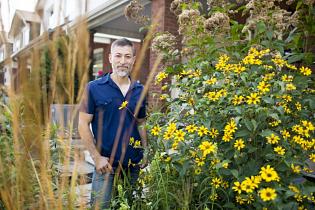East York resident wants city to add rain gardens to basement flooding subsidy
A bee hovers over late summer blooms as Marc Yamaguchi admits he didn’t spray a single drop of water on his garden this year.
Instead, he relied on rain water routed from roof to ground via a downspout. Known as a rain garden, Yamaguchi says it’s a green way to help prevent basement flooding, manage storm water and improve water quality.
As one the founders of the Rain Gardens United initiative, Yamaguchi has been pushing for residents to adopt the rain garden design since 2015. In three years, the initiative has achieved 31 rain gardens, mostly in Yamaguchi’s East York neighbourhood.
“The idea is to make water go down as opposed to across my property,” Yamaguchi said. “A rain garden prevents water from meandering back into my home, and instead feeds the plants.”
He’s experienced basement flooding first hand, with a slow leak damaging the floor and his family’s belongings.
In 2015, he built a rain garden for about $1,000, which included digging a metre-deep hole a few metres away from his house and refilling it with a combination of the area’s natural sandy soil and loosely compacted “good stuff” – peat moss, pulverized mulch and compost. He redirected his downspout from his driveway to his rain garden and planted hearty, native perennial species.
Since then, his basement has stayed dry.
Rain gardens like Yamaguchi’s can hold up to 30 per cent more water than a patch of grass, according to the Toronto and Region Conservation Authority.
Comments
There are 0 comments on this post





